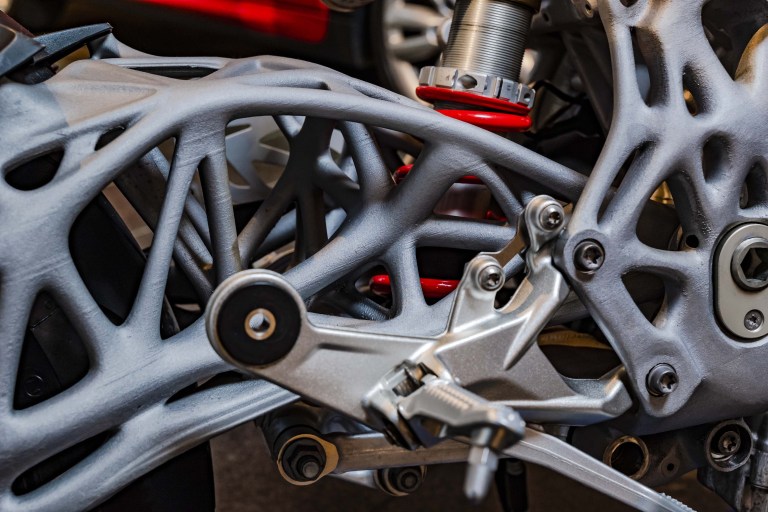BMW Shows Off 3D Printed S1000RR Frame
Ultimately, I think we are going to come back to this story several times over the next few weeks, as there is so much going on here, from such a simple thing, that one story just won’t do it all justice.
To start things off though, let’s look at the basics…as the BMW Group recently hosted what it called the BMW Group Digital Day 2018, which was basically a showcase for all the cool technologies that the Bavarians are using to create a digital frontier that will reshape the human condition.
Most of the technology concerns BMW’s automotive business, but there was one little tidbit that could be of interest for motorcycle fans: the 3D printed frame for a BMW S1000RR superbike.
 Built using additive manufacturing technology (selective laser melting, to be precise), a chassis is created a computer file and metal dust.
Built using additive manufacturing technology (selective laser melting, to be precise), a chassis is created a computer file and metal dust.
As you can see from the photos, the finish is pretty rough, and we are not sure what the strength properties are of the final product, but the concept has intriguing implications for the future of motorcycle design, manufacturing, and delivery.
To explore these ideas, BMW has created its own Additive Manufacturing Centre, in the BMW Group’s Research and Innovation Centre in Munich. The center can churn out roughly 140,000 prototype parts in a year, for BMW’s various R&D pursuits in its many divisions.
While the current use is mainly for prototyping, we have seen a couple additive manufacturing pieces make it into production vehicles, with the BMW i8 Roadster using 3D printed parts for its soft-top mounting mechanism.
 BMW isn’t the first manufacturer to be looking at additive manufacturing for a two-wheeled application, as a year-and-a-half ago we saw the Divergent 3D Dagger debut with a similar chassis, though it was holding a supercharged Kawasaki Ninja H2R motor at its core.
BMW isn’t the first manufacturer to be looking at additive manufacturing for a two-wheeled application, as a year-and-a-half ago we saw the Divergent 3D Dagger debut with a similar chassis, though it was holding a supercharged Kawasaki Ninja H2R motor at its core.
In addition to its 3D printing capabilities with metal, the BMW Group has also been working on ways to make carbon fiber part production more affordable – recently winning an award where they showcased a carbon fiber swingarm for the BMW G310R motorcycle.
If one is looking at the sign, the age of the conventional chassis design and manufacturing process is about to get turned on its head.
Of note, BMW Motorrad is said to be releasing its next iteration of the BMW S1000RR later this year, and while we expect the big new change for that superbike to be its counter-rotating engine, it would be neat to see BMW surprise us in the chassis category.
2019 might be too early to see these budding technology, but the next, next version certainly could. Stay tuned.
This article originally appeared on www.asphaltandrubber.com.
To start things off though, let’s look at the basics…as the BMW Group recently hosted what it called the BMW Group Digital Day 2018, which was basically a showcase for all the cool technologies that the Bavarians are using to create a digital frontier that will reshape the human condition.
Most of the technology concerns BMW’s automotive business, but there was one little tidbit that could be of interest for motorcycle fans: the 3D printed frame for a BMW S1000RR superbike.
 Built using additive manufacturing technology (selective laser melting, to be precise), a chassis is created a computer file and metal dust.
Built using additive manufacturing technology (selective laser melting, to be precise), a chassis is created a computer file and metal dust.As you can see from the photos, the finish is pretty rough, and we are not sure what the strength properties are of the final product, but the concept has intriguing implications for the future of motorcycle design, manufacturing, and delivery.
To explore these ideas, BMW has created its own Additive Manufacturing Centre, in the BMW Group’s Research and Innovation Centre in Munich. The center can churn out roughly 140,000 prototype parts in a year, for BMW’s various R&D pursuits in its many divisions.
While the current use is mainly for prototyping, we have seen a couple additive manufacturing pieces make it into production vehicles, with the BMW i8 Roadster using 3D printed parts for its soft-top mounting mechanism.
 BMW isn’t the first manufacturer to be looking at additive manufacturing for a two-wheeled application, as a year-and-a-half ago we saw the Divergent 3D Dagger debut with a similar chassis, though it was holding a supercharged Kawasaki Ninja H2R motor at its core.
BMW isn’t the first manufacturer to be looking at additive manufacturing for a two-wheeled application, as a year-and-a-half ago we saw the Divergent 3D Dagger debut with a similar chassis, though it was holding a supercharged Kawasaki Ninja H2R motor at its core.In addition to its 3D printing capabilities with metal, the BMW Group has also been working on ways to make carbon fiber part production more affordable – recently winning an award where they showcased a carbon fiber swingarm for the BMW G310R motorcycle.
If one is looking at the sign, the age of the conventional chassis design and manufacturing process is about to get turned on its head.
Of note, BMW Motorrad is said to be releasing its next iteration of the BMW S1000RR later this year, and while we expect the big new change for that superbike to be its counter-rotating engine, it would be neat to see BMW surprise us in the chassis category.
2019 might be too early to see these budding technology, but the next, next version certainly could. Stay tuned.
This article originally appeared on www.asphaltandrubber.com.




